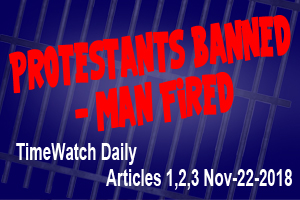
Bastille Day – July 14, 1789
TimeWatch Editorial
July 16, 2016
It is without doubt a significant fact that the recent attack upon French citizens occurred on July 14, 2016. There was a joyous assembly of thousands as they celebrated the storming of the Bastille. Suddenly a truck rushes through the crowd, killing about eighty-four individuals. The immediate conclusion was that a lone assassin influenced by ISIS was the perpetrator. It is however noteworthy that this took place on Bastille Day.
Bastille Day July 14, 1789, is the celebration of the beginnings of the French Revolution. France was under the authoritarian control of the Papacy. They desired freedom, desired to be released from the bondage that imprisoned them.Gemma Betros writes the following on the History Today Website:
“In 1789, the year of the outbreak of the French Revolution, Catholicism was the official religion of the French state. The French Catholic Church, known as the Gallican Church, recognized the authority of the pope as head of the Roman Catholic Church but had negotiated certain liberties that privileged the authority of the French monarch, giving it a distinct national identity characterized by considerable autonomy. France’s population of 28 million was almost entirely Catholic, with full membership of the state denied to Protestant and Jewish minorities. Being French effectively meant being Catholic. Yet, by 1794, France’s churches and religious orders were closed down and religious worship suppressed. How did it come to this? What did revolutionaries hope to achieve? And why did Napoleon set out to reverse the situation?” Gemma Betros, The French Revolution and the Catholic Church, The History Today Website
But the dominance of Catholicism in France was not restricted to the religious; it included the political and the economic.
The Church’s revenue in 1789 was estimated at an immense – and possibly exaggerated – 150 million livres. It owned around six per cent of land throughout France, and its abbeys, churches, monasteries and convents, as well as the schools, hospitals and other institutions it operated, formed a visible reminder of the Church’s dominance in French society. The Church was also permitted to collect the tithe, worth a nominal one-tenth of agricultural production, and was exempt from direct taxation on its earnings. This prosperity caused considerable discontent, best illustrated in the cahiers de doléances, or ‘statements of grievances’, sent from throughout the kingdom to be discussed at the meeting of the Estates-General in May 1789. Calls for the reform or abolition of the tithe and for the limitation of Church property were joined by complaints from parish priests who, excluded from the wealth bestowed upon the upper echelons of the Church hierarchy, often struggled to get by. When crowds began to gather in Paris on 13 July 1789, the religious house of Saint-Lazare and its neighboring convent were among the first places searched for supplies and weapons. The Catholic Church may have been the church of the majority of the French people, but its wealth and perceived abuses meant that it did not always have their trust. Gemma Betros, The French Revolution and the Catholic Church, The History Today Website
It is therefore easy to see why the revolution developed into a movement to remove not just the influence of the church but the removal of religion itself. The pendulum swung to the other extreme. Secularization and reason took the place of faith and practice. The calendar was adjusted for no other reason but to obliterate the concept of a say of worship. Listen to Frank Tallett, in his book
"Dechristianizing France: The Year II and the Revolutionary Experience", Page 1:
“During the course of the year II much of France was subjected to a campaign of dechristianisation, the aim of which was the eradication of Catholic religious practice, and Catholicism itself. The campaign, which was at its most intense in the winter and spring of 1793-94, comprised a number of different activities. These ranged from the removal of plate, statues and other fittings from places of worship, the destruction of crosses, bells, shrines and other 'external signs of worship', the closure of churches, the enforced abdication and, occasionally, the marriage of constitutional priests, the substitution of a Revolutionary calendar for the Gregorian one, the alteration of personal and place names which had any ecclesiastical connotations to more suitably Revolutionary ones, through to the promotion of new cults, notably those of reason and of the Supreme Being.”Frank Tallett, "Dechristianizing France: The Year II and the Revolutionary Experience", Page 1.
It is clear therefore that the anger of Rome was intense. Revenge has always been the response of Rome. Rome does not forget. IN The Great Controversy, Page 571 and paragraph 1 the writer, Ellen G White says the following:
“The Roman Church now presents a fair front to the world, covering with apologies her record of horrible cruelties. She has clothed herself in Christlike garments; but she is unchanged. Every principle of the papacy that existed in past ages exists today. The doctrines devised in the darkest ages are still held. Let none deceive themselves. The papacy that Protestants are now so ready to honor is the same that ruled the world in the days of the Reformation, when men of God stood up, at the peril of their lives, to expose her iniquity. She possesses the same pride and arrogant assumption that lorded it over kings and princes, and claimed the prerogatives of God. Her spirit is no less cruel and despotic now than when she crushed out human liberty and slew the saints of the Most High.” The Great Controversy, Page 571 and paragraph 1
The unchanged remains unchanged. The warning remains a powerful warning and an explanation of the events we will continue to see around us.
Cameron A. Bowen







